Spain’s Controversial Valley of the Fallen
It’s hard to believe but it’s already been almost four years since I first left the States to teach English in Spain. After a sleepless trans-Atlantic flight, I caught my first glimpse of España over the western coast of Galicia, in the northwest. Cities along the densely-populated Rías Baixas glittered in the soft baby blueness of dawn—beneath thick clouds; this is Galicia we’re talking about, now—and it wasn’t long before the plane had passed over rolling hills and entered the meseta central, the high plains of central Spain.
Ávila was next, still neatly enclosed by its medieval walls, but what caught my attention the most as we crossed over the Guadarrama mountain range was a striking monumental cross that seemed to emerge from a heap of granite boulders. This fleeting image would soon be replaced by the sprawl of metropolitan Madrid and the runways of the Barajas airport, but it was unmistakably the lightning rod of modern Spanish society: el Valle de los Caídos, the Valley of the Fallen, a gargantuan, extremely-controversial monument to those who died in Spain’s brutal Civil War that raged during the late 1930s.
Let’s fast forward to last March, when I was hanging out in Madrid before my Easter break trip to Germany. While visiting El Escorial I decided to day-trip on my day-trip (Inception, much?) to the nearby Valley of the Fallen. I was the only non-Spaniard on the minibus that ran between San Lorenzo de El Escorial and the entrance to the complex, but this history nerd wasn’t surprised at all—the monument is hardly known outside of the country, and even within Spain it’s hugely polarizing.
In the aftermath of the Civil War, which had torn the fabric of the country in two along social, political, and religious lines, victorious dictator Francisco Franco ordered a memorial to be built ostensibly to honor the dead on both Republican and Nationalist sides. There would be a mausoleum for thousands of fallen soldiers to be buried in, a great underground basilica for masses, as well as a monastery whose monks would pray for the souls of the dead. It began with good intentions, but it ended up a monument to the fascist regime that won the Civil War.
The minibus dropped off me and half a dozen other uneasy visitors at a parking lot surrounded by spindly pine trees, which swayed in intense gusts of wind. The entrance was right around the corner: a stark, massive plaza totally devoid of people. The doors to the church backed up to a craggy hill, bounded on either side by twin colonnaded “arms” that reached out to surround the plaza. But while similar “arms” like those at St. Peter’s Square in the Vatican give the impression of a warm, inviting hug that welcomes all into the Church, here, these heavy, granite halls felt cold and menacing.
Once inside, it took my eyes a few minutes to adjust to the dark, gloomy interior. As the basilica was dug out of the hillside, the church had a completely different atmosphere from your typical light-filled cathedral. Dim accent lighting did little to offset the lack of windows, and the blinding sunlight from the plaza outside gradually dissipated the further I delved into the mountain.
As I took a step down from the lobby area into the church nave, I was greeted on either side by statues of downcast angels bearing swords. These statues were signs of what I would encounter in the rest of the Valley: a macabre alliance of Church and State.
Morose choral chants from speakers echoed against the walls and vaults, setting an appropriately solemn mood over the whole place. Larger-than-life Renaissance-style tapestries hung on the walls leading up the altar and depicted all of the wild and violent imagery of the biblical Book of Revelation in bizarre, literal fashion. And interspersed between each tapestry were side-chapels dedicated to each branch of the Spanish military.
While checking out the tapestries and side-chapels, I had to weave my way around glossy black cauldrons that were strewn across the floor. I looked up and realized they were catching water leaking from the ceiling, which was stained with minerals that had leached from the mountain above. It was almost as if the rocks themselves were weeping over the tragedy that was the Civil War.
As I made my way up to the high altar, the basilica opened up into a huge circular, domed chamber. But laying at the steps of the altar was the grave of José Antonio Primo de Rivera, who founded Spain’s fascist Falange party and who died at the outbreak of the Civil War in 1936. It was the Falange that led the Nationalists in overthrowing the Republican government in that war and ultimately ruled the country in a dictatorship until Francisco Franco died in 1975. That a fascist leader is buried here may come as a shock to outsiders, but keep in mind that the Spanish Catholic Church sided with with the Nationalists during the war and enjoyed a privileged status in society in the postwar era.
Moving on to the right wing of the main hall, I came to a small, claustrophobic chapel that felt more like an Egyptian burial tomb than a side chapel. A doorway in the corner was emblazoned with the words “Fallen—For God and For Spain—1936-1939—R I P.” Behind those doors lay the remains of thousands of soldiers who perished on both sides of the Civil War, bodies often removed from mass graves against the wishes of their surviving families, bodies often of Republican prisoners who worked on the Valley of the Fallen’s construction.
I continued my circuit around the high altar, behind which rose intricately-carved choir stalls of darkly-stained walnut wood. Many cathedrals in Spain still have their original wooden choir stalls, and in these carved sillerías you can pick up on characters from the Bible, saints of the church, or beautiful floral designs. When I looked closely at the Valley of the Fallen’s stalls, however, I was horrified to see scenes from the Crusades and Spain’s Reconquista, almost a holy war in its own right against Muslim rulers from North Africa. Let’s not forget that Franco stylized his military campaign as a “crusade” against the “godless communists” of the Republicans.
And that brings us to Franco himself. Turning to face the high altar, I noticed a small arrangement of fresh flowers resting on top of a plain but conspicuous grave that read simply: Francisco Franco. It boggles the mind that a modern European nation like Spain would continue to maintain the burial grounds of a fascist dictator, but remember that, unlike in Germany or Italy, in Spain, the fascists won. After Franco died in 1975 the country basically just swept the past under the rug and moved on with democracy.
Defying the “NO FOTOS” signs, I snapped a grainy shot of Franco’s tomb and hurried out of this dark, depressing site. The emotional power of the Valley of the Fallen was unlike any other place in Spain I visited in my three years in the country. I felt a mixture of outrage at the atrocities Franco & co. committed during and after the war, anger at the gall they had to build such a pro-fascist monument in the name of “all Spaniards,” grief over the thousands who perished in a pointless war, and even horror at such a terrifying marriage of Church and State.
Although it’s important not to forget the Spanish Civil War and Franco’s dictatorship, the Valley of the Fallen does a terrible job of educating visitors what actually went on, which is a real shame. Unless you have a passion for and knowledge of Spanish history, I would recommend skipping this site in favor of lingering at El Escorial and going hiking in the surrounding hills.
But if you do decide to check it out, you can buy a combo bus + entrance ticket at the San Lorenzo de El Escorial bus station. Bus route 660-A leaves El Escorial at 3:15pm, and picks you up at the Valley two hours later at 5:30pm. Fortunately there’s a café-restaurant nearby if you finish early and need an afternoon pick-me-up.
For more info, you should read Lauren Aloise’s blog post “Visiting Valle de los Caídos (Valley of the Fallen)” and El País in English’s “The Valley of the Fallen — the problem that won’t go away.”
What do you think the Spanish state should do with the Valley of the Fallen? Keep it as it is, shut it down, or convert it into a museum? Add your opinion to the inevitable flame war below!

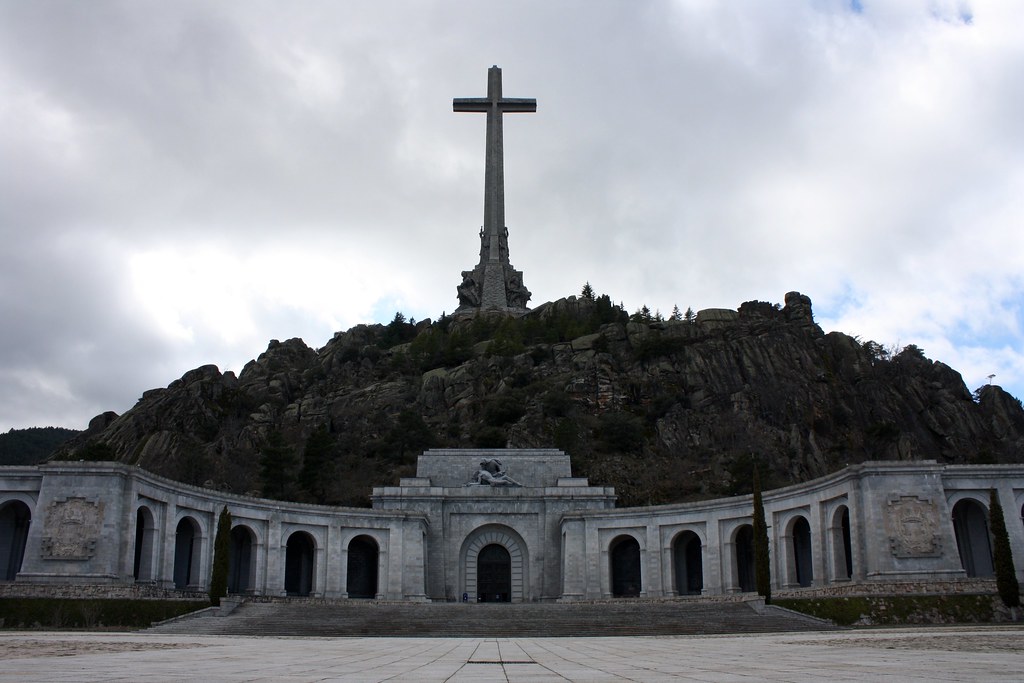 |
| The entrance |
Ávila was next, still neatly enclosed by its medieval walls, but what caught my attention the most as we crossed over the Guadarrama mountain range was a striking monumental cross that seemed to emerge from a heap of granite boulders. This fleeting image would soon be replaced by the sprawl of metropolitan Madrid and the runways of the Barajas airport, but it was unmistakably the lightning rod of modern Spanish society: el Valle de los Caídos, the Valley of the Fallen, a gargantuan, extremely-controversial monument to those who died in Spain’s brutal Civil War that raged during the late 1930s.
Let’s fast forward to last March, when I was hanging out in Madrid before my Easter break trip to Germany. While visiting El Escorial I decided to day-trip on my day-trip (Inception, much?) to the nearby Valley of the Fallen. I was the only non-Spaniard on the minibus that ran between San Lorenzo de El Escorial and the entrance to the complex, but this history nerd wasn’t surprised at all—the monument is hardly known outside of the country, and even within Spain it’s hugely polarizing.
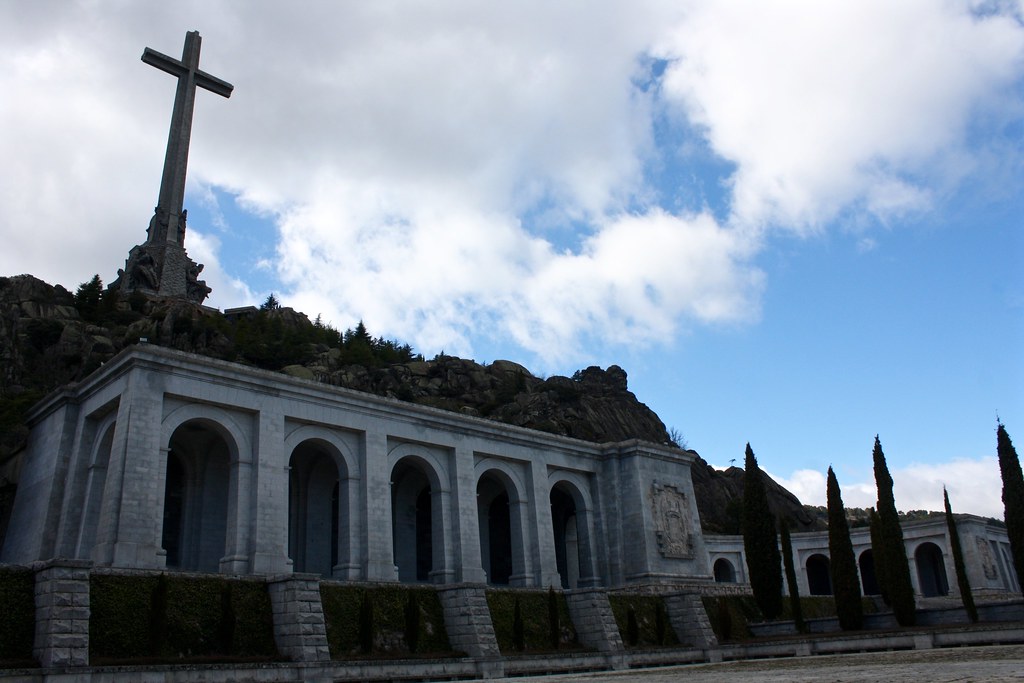 |
| At the plaza |
In the aftermath of the Civil War, which had torn the fabric of the country in two along social, political, and religious lines, victorious dictator Francisco Franco ordered a memorial to be built ostensibly to honor the dead on both Republican and Nationalist sides. There would be a mausoleum for thousands of fallen soldiers to be buried in, a great underground basilica for masses, as well as a monastery whose monks would pray for the souls of the dead. It began with good intentions, but it ended up a monument to the fascist regime that won the Civil War.
The minibus dropped off me and half a dozen other uneasy visitors at a parking lot surrounded by spindly pine trees, which swayed in intense gusts of wind. The entrance was right around the corner: a stark, massive plaza totally devoid of people. The doors to the church backed up to a craggy hill, bounded on either side by twin colonnaded “arms” that reached out to surround the plaza. But while similar “arms” like those at St. Peter’s Square in the Vatican give the impression of a warm, inviting hug that welcomes all into the Church, here, these heavy, granite halls felt cold and menacing.
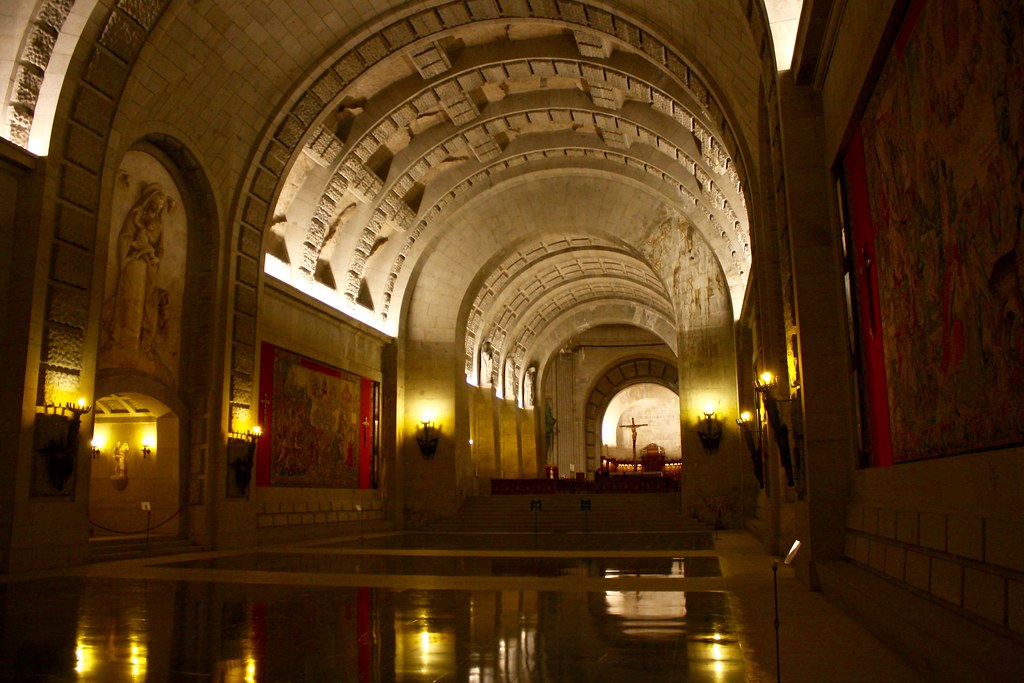 |
| Inside the nave |
Once inside, it took my eyes a few minutes to adjust to the dark, gloomy interior. As the basilica was dug out of the hillside, the church had a completely different atmosphere from your typical light-filled cathedral. Dim accent lighting did little to offset the lack of windows, and the blinding sunlight from the plaza outside gradually dissipated the further I delved into the mountain.
As I took a step down from the lobby area into the church nave, I was greeted on either side by statues of downcast angels bearing swords. These statues were signs of what I would encounter in the rest of the Valley: a macabre alliance of Church and State.
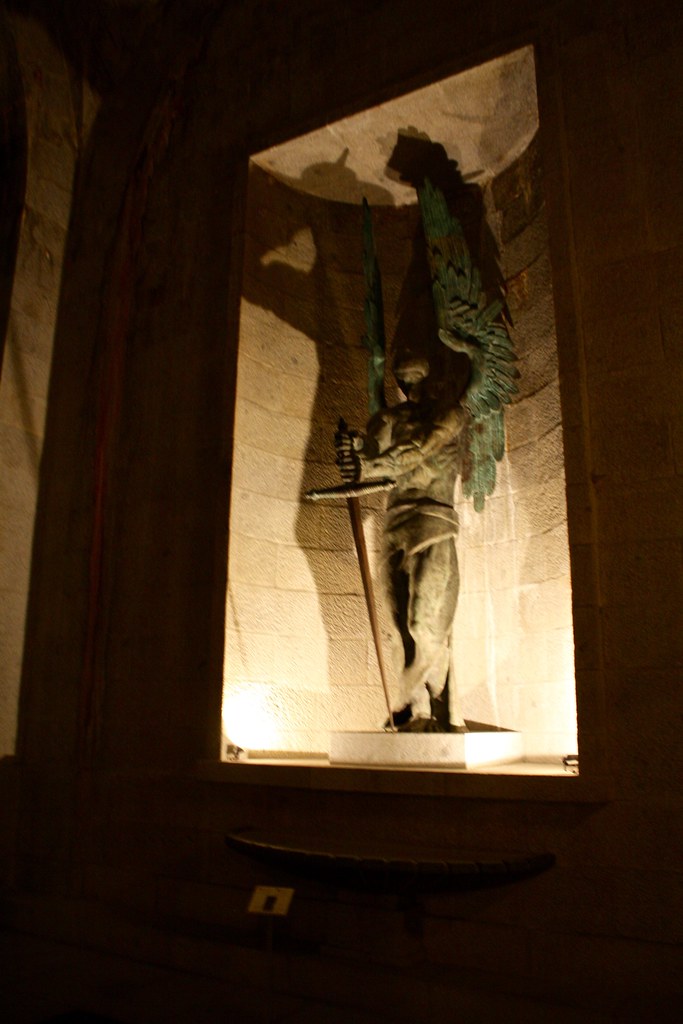 |
| Angel statue |
Morose choral chants from speakers echoed against the walls and vaults, setting an appropriately solemn mood over the whole place. Larger-than-life Renaissance-style tapestries hung on the walls leading up the altar and depicted all of the wild and violent imagery of the biblical Book of Revelation in bizarre, literal fashion. And interspersed between each tapestry were side-chapels dedicated to each branch of the Spanish military.
While checking out the tapestries and side-chapels, I had to weave my way around glossy black cauldrons that were strewn across the floor. I looked up and realized they were catching water leaking from the ceiling, which was stained with minerals that had leached from the mountain above. It was almost as if the rocks themselves were weeping over the tragedy that was the Civil War.
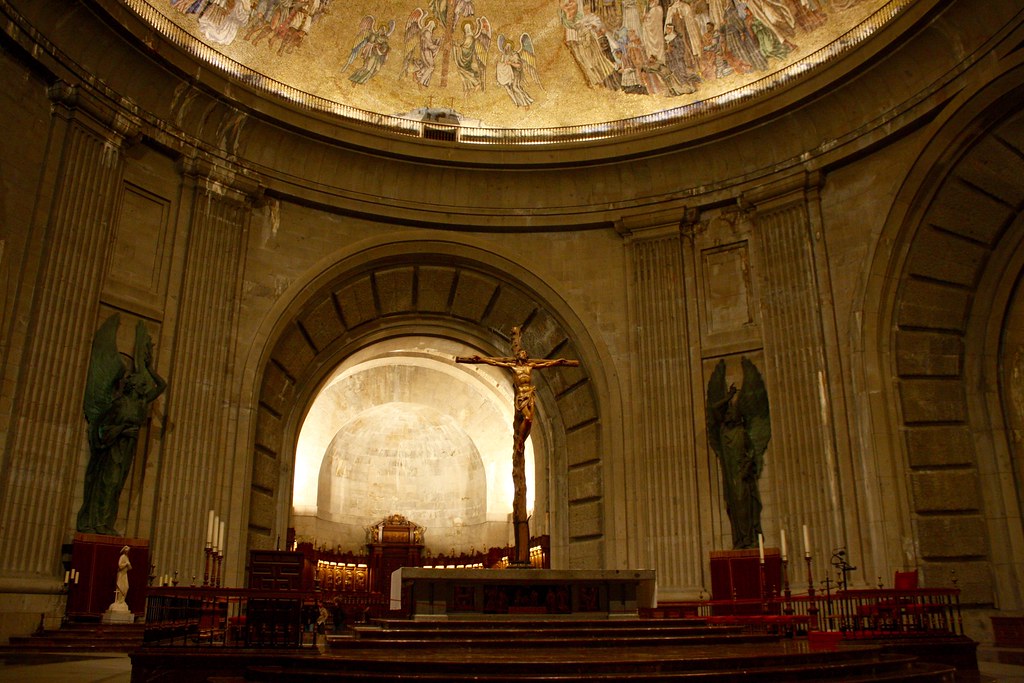 |
| The high altar |
As I made my way up to the high altar, the basilica opened up into a huge circular, domed chamber. But laying at the steps of the altar was the grave of José Antonio Primo de Rivera, who founded Spain’s fascist Falange party and who died at the outbreak of the Civil War in 1936. It was the Falange that led the Nationalists in overthrowing the Republican government in that war and ultimately ruled the country in a dictatorship until Francisco Franco died in 1975. That a fascist leader is buried here may come as a shock to outsiders, but keep in mind that the Spanish Catholic Church sided with with the Nationalists during the war and enjoyed a privileged status in society in the postwar era.
Moving on to the right wing of the main hall, I came to a small, claustrophobic chapel that felt more like an Egyptian burial tomb than a side chapel. A doorway in the corner was emblazoned with the words “Fallen—For God and For Spain—1936-1939—R I P.” Behind those doors lay the remains of thousands of soldiers who perished on both sides of the Civil War, bodies often removed from mass graves against the wishes of their surviving families, bodies often of Republican prisoners who worked on the Valley of the Fallen’s construction.
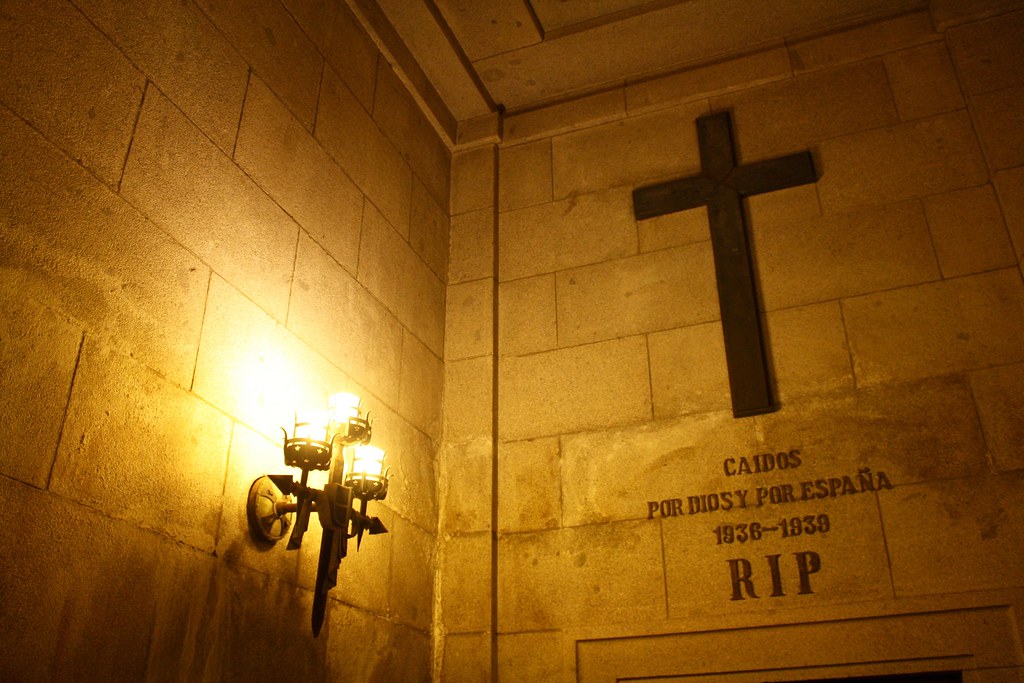 |
| At one of the side-chapels |
I continued my circuit around the high altar, behind which rose intricately-carved choir stalls of darkly-stained walnut wood. Many cathedrals in Spain still have their original wooden choir stalls, and in these carved sillerías you can pick up on characters from the Bible, saints of the church, or beautiful floral designs. When I looked closely at the Valley of the Fallen’s stalls, however, I was horrified to see scenes from the Crusades and Spain’s Reconquista, almost a holy war in its own right against Muslim rulers from North Africa. Let’s not forget that Franco stylized his military campaign as a “crusade” against the “godless communists” of the Republicans.
And that brings us to Franco himself. Turning to face the high altar, I noticed a small arrangement of fresh flowers resting on top of a plain but conspicuous grave that read simply: Francisco Franco. It boggles the mind that a modern European nation like Spain would continue to maintain the burial grounds of a fascist dictator, but remember that, unlike in Germany or Italy, in Spain, the fascists won. After Franco died in 1975 the country basically just swept the past under the rug and moved on with democracy.
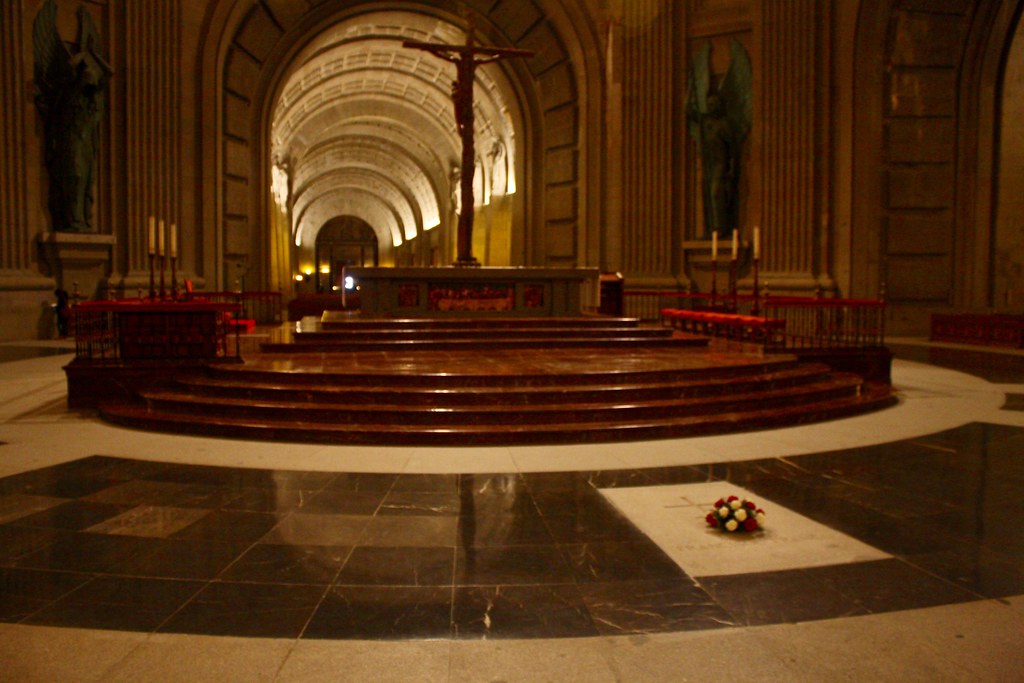 |
| Francisco Franco’s grave |
Defying the “NO FOTOS” signs, I snapped a grainy shot of Franco’s tomb and hurried out of this dark, depressing site. The emotional power of the Valley of the Fallen was unlike any other place in Spain I visited in my three years in the country. I felt a mixture of outrage at the atrocities Franco & co. committed during and after the war, anger at the gall they had to build such a pro-fascist monument in the name of “all Spaniards,” grief over the thousands who perished in a pointless war, and even horror at such a terrifying marriage of Church and State.
How to get there
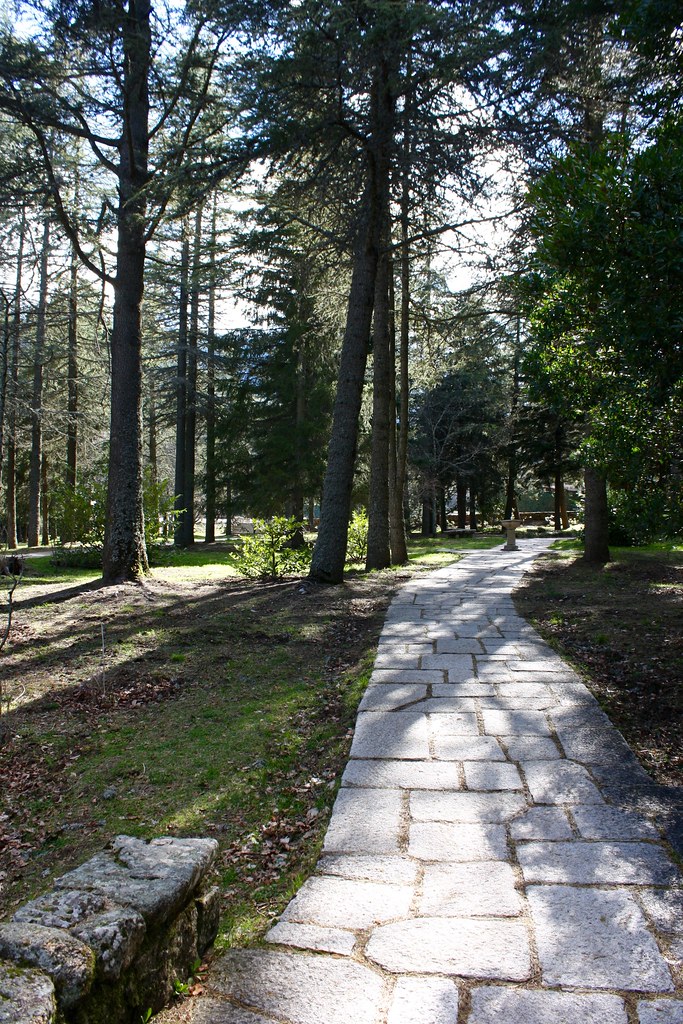 |
| Mountain pine forest |
Although it’s important not to forget the Spanish Civil War and Franco’s dictatorship, the Valley of the Fallen does a terrible job of educating visitors what actually went on, which is a real shame. Unless you have a passion for and knowledge of Spanish history, I would recommend skipping this site in favor of lingering at El Escorial and going hiking in the surrounding hills.
But if you do decide to check it out, you can buy a combo bus + entrance ticket at the San Lorenzo de El Escorial bus station. Bus route 660-A leaves El Escorial at 3:15pm, and picks you up at the Valley two hours later at 5:30pm. Fortunately there’s a café-restaurant nearby if you finish early and need an afternoon pick-me-up.
For more info, you should read Lauren Aloise’s blog post “Visiting Valle de los Caídos (Valley of the Fallen)” and El País in English’s “The Valley of the Fallen — the problem that won’t go away.”
What do you think the Spanish state should do with the Valley of the Fallen? Keep it as it is, shut it down, or convert it into a museum? Add your opinion to the inevitable flame war below!
